高中英语阅读理解6-推理判断题讲义
- 格式:doc
- 大小:130.00 KB
- 文档页数:10
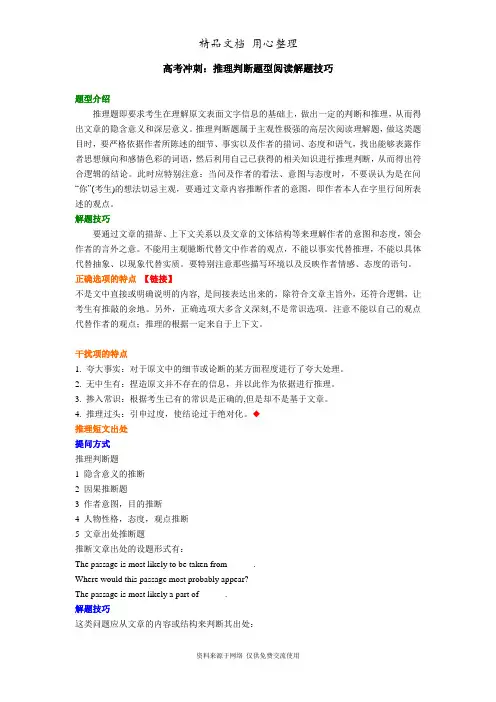
高考冲刺:推理判断题型阅读解题技巧题型介绍推理题即要求考生在理解原文表面文字信息的基础上,做出一定的判断和推理,从而得出文章的隐含意义和深层意义。
推理判断题属于主观性极强的高层次阅读理解题,做这类题目时,要严格依据作者所陈述的细节、事实以及作者的措词、态度和语气,找出能够表露作者思想倾向和感情色彩的词语,然后利用自己已获得的相关知识进行推理判断,从而得出符合逻辑的结论。
此时应特别注意:当问及作者的看法、意图与态度时,不要误认为是在问“你”(考生)的想法切忌主观,要通过文章内容推断作者的意图,即作者本人在字里行间所表述的观点。
解题技巧要通过文章的措辞、上下文关系以及文章的文体结构等来理解作者的意图和态度,领会作者的言外之意。
不能用主观臆断代替文中作者的观点,不能以事实代替推理,不能以具体代替抽象、以现象代替实质。
要特别注意那些描写环境以及反映作者情感、态度的语句。
正确选项的特点【链接】不是文中直接或明确说明的内容, 是间接表达出来的,除符合文章主旨外,还符合逻辑,让考生有推敲的余地。
另外,正确选项大多含义深刻,不是常识选项。
注意不能以自己的观点代替作者的观点;推理的根据一定来自于上下文。
干扰项的特点1. 夸大事实:对于原文中的细节或论断的某方面程度进行了夸大处理。
2. 无中生有:捏造原文并不存在的信息,并以此作为依据进行推理。
3. 掺入常识:根据考生已有的常识是正确的,但是却不是基于文章。
4. 推理过头:引申过度,使结论过于绝对化。
◆推理短文出处提问方式推理判断题1 隐含意义的推断2 因果推断题3 作者意图,目的推断4 人物性格,态度,观点推断5 文章出处推断题推断文章出处的设题形式有:The passage is most likely to be taken from______.Where would this passage most probably appear?The passage is most likely a part of______.解题技巧这类问题应从文章的内容或结构来判断其出处:1. 报纸:前面会出现日期、地点或通讯社名称。
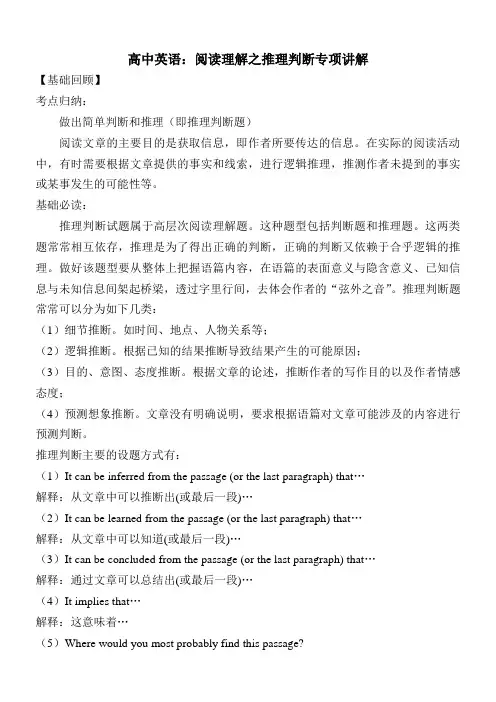
高中英语:阅读理解之推理判断专项讲解【基础回顾】考点归纳:做出简单判断和推理(即推理判断题)阅读文章的主要目的是获取信息,即作者所要传达的信息。
在实际的阅读活动中,有时需要根据文章提供的事实和线索,进行逻辑推理,推测作者未提到的事实或某事发生的可能性等。
基础必读:推理判断试题属于高层次阅读理解题。
这种题型包括判断题和推理题。
这两类题常常相互依存,推理是为了得出正确的判断,正确的判断又依赖于合乎逻辑的推理。
做好该题型要从整体上把握语篇内容,在语篇的表面意义与隐含意义、已知信息与未知信息间架起桥梁,透过字里行间,去体会作者的“弦外之音”。
推理判断题常常可以分为如下几类:(1)细节推断。
如时间、地点、人物关系等;(2)逻辑推断。
根据已知的结果推断导致结果产生的可能原因;(3)目的、意图、态度推断。
根据文章的论述,推断作者的写作目的以及作者情感态度;(4)预测想象推断。
文章没有明确说明,要求根据语篇对文章可能涉及的内容进行预测判断。
推理判断主要的设题方式有:(1)It can be inferred from the passage (or the last paragraph) that…解释:从文章中可以推断出(或最后一段)…(2)It can be learned from the passage (or the last paragraph) that…解释:从文章中可以知道(或最后一段)…(3)It can be concluded from the passage (or the last paragraph) that…解释:通过文章可以总结出(或最后一段)…(4)It implies that…解释:这意味着…(5)Where would you most probably find this passage?解释:你最有可能在哪里找到这篇文章?(6)What would the author most likely continue to talk about in the next paragraph(s)?解释:作者很可能会在下一段(或下文中)继续谈论什么?【技能方法】推理判断主要的解题策略有:(1)根据不同文体,推断目的意图。
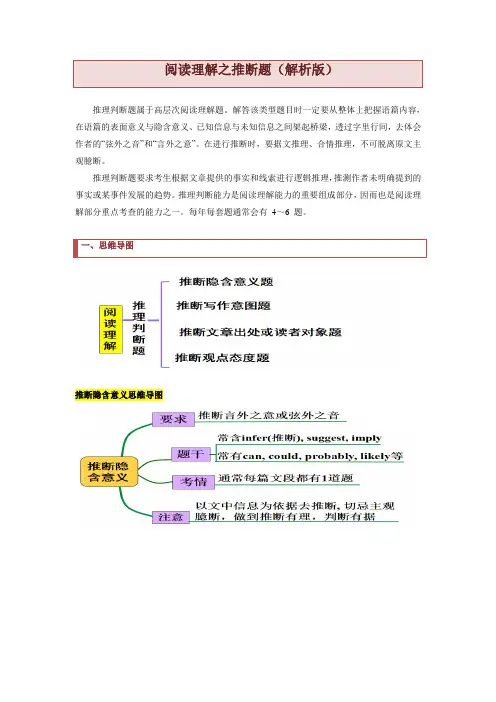
阅读理解之推断题(解析版)推理判断题属于高层次阅读理解题。
解答该类型题目时一定要从整体上把握语篇内容,在语篇的表面意义与隐含意义、已知信息与未知信息之间架起桥梁,透过字里行间,去体会作者的“弦外之音”和“言外之意”。
在进行推断时,要据文推理、合情推理,不可脱离原文主观臆断。
推理判断题要求考生根据文章提供的事实和线索进行逻辑推理,推测作者未明确提到的事实或某事件发展的趋势。
推理判断能力是阅读理解能力的重要组成部分,因而也是阅读理解部分重点考查的能力之一。
每年每套题通常会有4~6 题。
一、思维导图推断隐含意义思维导图二、方法点拨(一)推理判断题题干常用词一般来说,推理判断题题干中主要包括下面的词语:know about, learn from, infer, imply, suggest, conclude, purpose, attitude, probably, most likely等。
(二)推理判断题正确选项特征推理判断题中的正确选项是依据文章的事实或证据推断出的符合逻辑的结论或观点,正确选项一般具有以下特征:1.“立足原文,只推一步”,即根据原文内容,一步即可推得。
2.选项中一般不可以出现绝对概念。
如only, never, all, absolutely等,正确答案的表述一般有一点模糊,会用一些相对能够留有一些余地的词汇,如often, usually, sometimes, some, may, might, can, could, possibly, probably等。
(三)推理判断题干扰选项特征1.曲解文意:即推测意义与文章表层意义有区别。
推理判断题中有些选项来自文章中的某一句或某几句话,命题者可能会利用里面的词设计出干扰项,看似表达文章的意思,其实是借题发挥,是对原文意思的曲解。
2.张冠李戴:即把文章中作者的观点与其他人的观点混淆在一起。
题干问的是作者的观点,选项中出现的却是其他人的观点;题干问的是其他人的观点,选项中却出现了作者的观点。
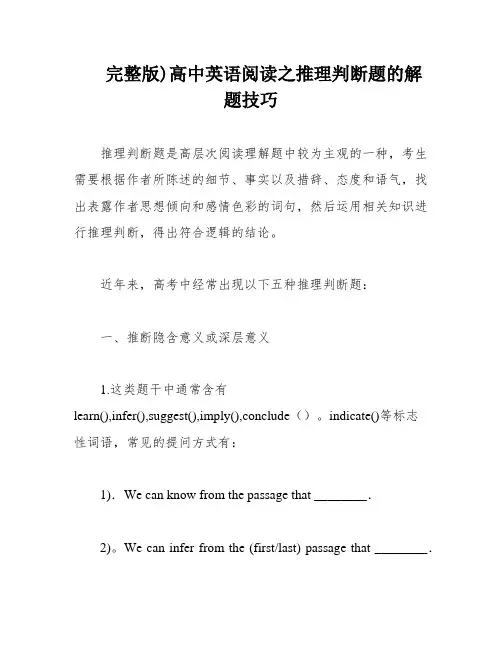
完整版)高中英语阅读之推理判断题的解题技巧推理判断题是高层次阅读理解题中较为主观的一种,考生需要根据作者所陈述的细节、事实以及措辞、态度和语气,找出表露作者思想倾向和感情色彩的词句,然后运用相关知识进行推理判断,得出符合逻辑的结论。
近年来,高考中经常出现以下五种推理判断题:一、推断隐含意义或深层意义1.这类题干中通常含有learn(),infer(),suggest(),imply(),conclude()。
indicate()等标志性词语,常见的提问方式有:1).We can know from the passage that ________.2)。
We can infer from the (first/last) passage that ________.3).___ ______.4).It ___ ________.5).The underlined sentence indicates that ________2.解题技巧①针对细节推断:在原文中找到相关的信息源,对具体内容进行分析,推理判断得出结论。
例如,原文中提到“你是否曾经听到过从墙壁里传来的奇怪声音?它听起来像是一个时钟吗?如果是的话,那可能是由一个甲虫制造的。
很久以前,人们认为这个滴答声意味着有人即将死去。
因此,这种甲虫被称为“死亡守望者甲虫”。
从文中可以推断出,这种甲虫的声音让人感到________。
A.高兴B.惊讶C.恐惧D.兴奋需要填的是C,因为文中明确提到人们曾经认为这种声音意味着有人即将死去,因此可以推断出这种声音让人感到恐惧。
Why ___ any good news。
All I read about is murder。
bribery。
and death。
Frankly。
I’m sick of all the bad news.The author ___。
___ with the constant barrage of bad news。
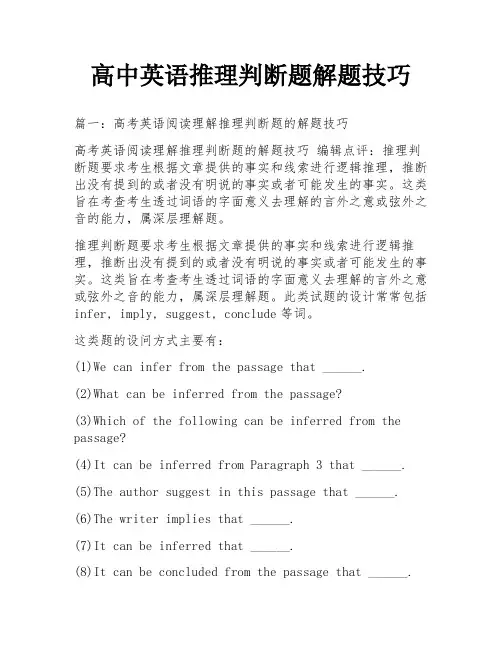
高中英语推理判断题解题技巧篇一:高考英语阅读理解推理判断题的解题技巧高考英语阅读理解推理判断题的解题技巧编辑点评:推理判断题要求考生根据文章提供的事实和线索进行逻辑推理,推断出没有提到的或者没有明说的事实或者可能发生的事实。
这类旨在考查考生透过词语的字面意义去理解的言外之意或弦外之音的能力,属深层理解题。
推理判断题要求考生根据文章提供的事实和线索进行逻辑推理,推断出没有提到的或者没有明说的事实或者可能发生的事实。
这类旨在考查考生透过词语的字面意义去理解的言外之意或弦外之音的能力,属深层理解题。
此类试题的设计常常包括infer, imply, suggest, conclude等词。
这类题的设问方式主要有:(1)We can infer from the passage that ______.(2)What can be inferred from the passage?(3)Which of the following can be inferred from the passage?(4)It can be inferred from Paragraph 3 that ______.(5)The author suggest in this passage that ______.(6)The writer implies that ______.(7)It can be inferred that ______.(8)It can be concluded from the passage that ______.(9)On the whole, we can conclude that ______.(10)From the text we can conclude that ______.(11)After reading the passage we may conclude that______.(12)What conclusion can be drawn from the passage?(13)The author is inclined to think that ______.(14)When the writer talks about..., what he really means is that______.(15)What's the writer's attitude towards...?(16)What's the author's feeling towards...?(17)In the writer's opinion...理解文段的隐含信息包括:推测或人物的观点、态度、意图、身份、情感,对或文段所涉及的人物、事件作出评价等,属于深层理解,是语言学习者必须具备的交际能力之一。
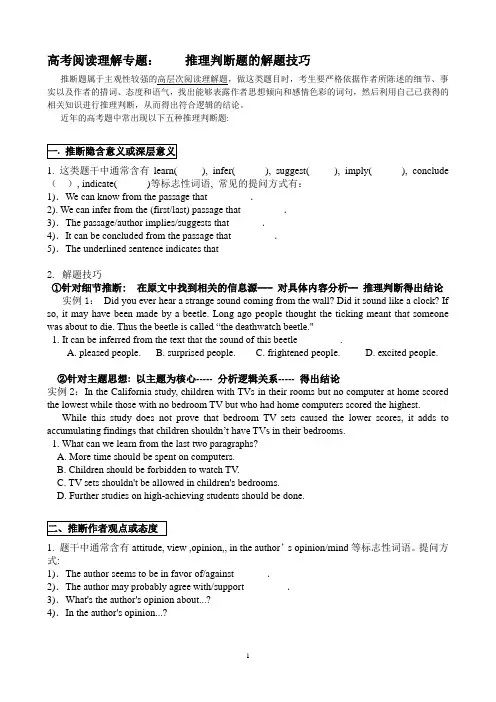
高考阅读理解专题:推理判断题的解题技巧推断题属于主观性较强的高层次阅读理解题,做这类题目时,考生要严格依据作者所陈述的细节、事实以及作者的措词、态度和语气,找出能够表露作者思想倾向和感情色彩的词句,然后利用自己已获得的相关知识进行推理判断,从而得出符合逻辑的结论。
近年的高考题中常出现以下五种推理判断题:1. 这类题干中通常含有learn( ), infer( ), suggest( ), imply( ), conclude (), indicate( )等标志性词语, 常见的提问方式有:1).We can know from the passage that ________.2). We can infer from the (first/last) passage that ________.3).The passage/author implies/suggests that ______.4).It can be concluded from the passage that ________.5).The underlined sentence indicates that ________2. 解题技巧①针对细节推断: 在原文中找到相关的信息源--- 对具体内容分析-- 推理判断得出结论实例1:Did you ever hear a strange sound coming from the wall? Did it sound like a clock? If so, it may have been made by a beetle. Long ago people thought the ticking meant that someone was about to die. Thus the beetle is called “the deathwatch beetle."1. It can be inferred from the text that the sound of this beetle ________.A. pleased people.B. surprised people.C. frightened people.D. excited people.②针对主题思想:以主题为核心----- 分析逻辑关系----- 得出结论实例2:In the California study, children with TVs in their rooms but no computer at home scored the lowest while those with no bedroom TV but who had home computers scored the highest.While this study does not prove that bedroom TV sets caused the lower scores, it adds to accumulating findings that children shouldn’t have TVs in their bedrooms.1. What can we learn from the last two paragraphs?A. More time should be spent on computers.B. Children should be forbidden to watch TV.C. TV sets shouldn't be allowed in children's bedrooms.D. Further studies on high-achieving students should be done.1. 题干中通常含有attitude, view ,opinion,, in the author’s opinion/mind等标志性词语。

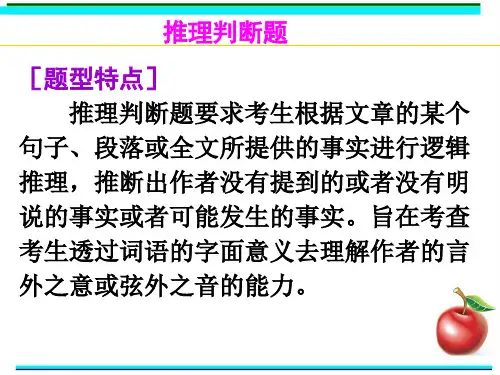

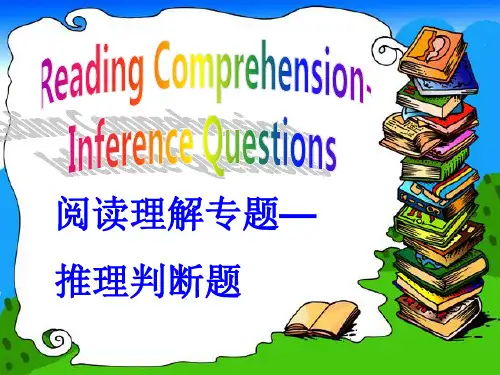

高考英语阅读理解推理判断题解题技巧阅读能力的考查不但要求理解具体事实细节,也要求理解抽象的含义,既要求理解字面意思,又要求理解其深层含义,包括作者的态度、观点、意图等;既要求理解文章中某句、某段的含义及全文的逻辑关系,又要求根据其含义及逻辑关系进行推理和判断。
推理判断属于高层次阅读理解,在解答时应注意以下几点:1.掌握常见的提问形式常用infer, imply, suggest, conclude, learn, intend, mean, describe, purpose等词提问,或提问中含有表示推测的情态动词,如:can, could, might, would等何其他表示可能性的副词或词组,如 probably, most likely 等。
2. 解题思路做题时一定要从整体上把握语篇内容,在语篇的表面意义与隐含意义、已知信息与未知信息间架起桥梁,透过字里行间,去体会作者的“弦外音”.在阅读是要抓住文章的主题和细节,分析文章结构,根据上下文内在联系,挖掘文章的深沉含义。
首先在进行推理时,要仔细阅读短文,千万不可脱离原文而凭个人的看法,主观臆断。
其次对于暗含在文章中的人物的行为动机。
事件的因果关系及作者未言明的倾向、意图、态度、观点等要进行合乎逻辑的推断。
推理分析,进一步增强理解能力,抓住材料实质性的东西。
再次,在解答推理问题时,应清楚所要解答的问题是针对某个细节进行判断,还是针对主题思、作者的意图进行判断。
针对细节的推断可运用略读的方法,迅速在阅读材料中确定推理依据的位置或范围,然后在进行推理判断。
针对主题思想进行判断时,其解题的主要依据是文章的主题思想,然后再分析句子之间的逻辑关系,区分观点与例证(opinion and fact )、原因与结果( cause and effect) ,主观点与次观点( main idea and supporting idea )3.推理题的解题方法(1)抓住特定的信息进行逆向或正向推理做此类试题时,要善于某一段话中的关键信息,即某些关键词或短语去分析、推理判断,利用逆向思维或正向推理,从而推断出这句话所隐含的深层含义。
高中英语《阅读理解》高考研究——推理判断题一、考纲解读(考点呈现)历届高考英语试题中,推理判断题的考查每年都占阅读理解试题一半左右,它将直接影响考生的英语整体成绩。
推理判断题属于主观题,是层次较高的题目。
阅读文章的主要目的是获取信息,即作者所要传达的信息。
在实际的阅读活动中,有时需要根据文章提供的事实和线索,进行逻辑推理,推测作者未提到的事实或某事发生的可能性等。
每篇文章都有一个特定的写作目的,或是向读者传递某个信息,或是愉悦读者,或是讲授某个道理。
而这些信息通常并不是明确表达出来,而是隐含在文章之中。
因此,这类问题要求考生在理解文章总体内容的基础上,去领会作者的言外之意。
二、真题解析1.真题呈现2013年湖北卷阅读理解D篇考查了3道推理判断题DThe technology is great. Without it we wouldn’t have been able to put a man on the moon, explore the ocean’s depths or eat microwave sausages. Computers have revolutionized our lives and they have the power to educate and pass on knowledge. But sometimes this power can create more problems than itsolves.Every doctor has had to try their best to calm down patients who’ve come into their surgery waving an Internet print-out, convinced that they have some rare incurable disease, say, throat cancer. The truth is usually far more ordinary, though: they don’t have throat cancer, and it’s just that their throats are swollen. Being a graduate of the Internet “school” of medicine does not guarantee accurate self-health-checks.One day Mrs. Almond came to my hospital after feeling faint at work. While I took her blood sample and tried to find out what was wrong, she said calmly, “I know what’s wrong; I’ve got throat cancer. I know there’s nothing you doctors can do about it and I’ve just got to wait until the day comes.”As a matter of routine I ordered a chest X-ray. I looked at it and the blood results an hour later. Something wasn’t right. “Did your local doctor do an X-ray?” I asked. “Oh, I haven’t been to the doctor for years,” she replied. “I read about it on a website and the symptoms fitted, so I knew that’s what I had.”However, some of her symptoms, like the severe cough and weight loss, didn’t fit with it—but she’d just ignored this.I looked at the X-ray again, and more tests confirmed it wasn’t the cancer but tuberculosis (肺结核)—something that most certainly did need treating, and could be deadly. She was lucky we caught it when we did.Mrs. Almond went pale when I explained she would have to be on treatment for the next six months to ensure that she was fully recovered. It w as certainly a lesson for her. “I’m so embarrassed,” she said, shaking her head, as I explained that all the people she had come into close contact with would have to be found out and tested. She listed up to about 20, and then I went to my office to type up my notes. Unexpectedly, the computer was not working, so I had to wait until someone from the IT department came to fix it. Typical. Maybe I should havea microwave sausage while I waited?64. It was lucky for Mrs. Almond ______.A. to have contacted many friendsB. to have recovered in a short timeC. to have her assumption confirmedD. to have her disease identified in time65. Mrs. Almond said “I’m so embarrassed” (Para. 7) because ______.A. she had distrusted her close friendsB. she had caused unnecessary troubleC. she had to refuse the doctor’s adviceD. she had to tell the truth to the doctor66. By mentioning the breakdown of the computer, the author probably wants to prove ______.A. it’s a must to take a break at workB. it’s vital to believe in IT professionalsC. it’s unwise to simply rely on technologyD. it’s a danger to work long hours on computers参考答案:64. D 【命题立意】推理判断题。
advance?
1. This passage must be taken from a _______. A. novel B. letter C. newspaper D. diary
2. In the passage, “you” refers to _______.
A. a friend of the writer’s
B. the reader who reads the passage
C. some person who has a cottage for hire
D. an unknown person living in England
3. According to the passage, which of the following is NOT true?
A. “You” must have advertised in the newspaper.
B. The writer and her husband are to stay at Dedham.
C. The writer must have been to Dedham ten years ago.
D. The writer is interested in nothing but the cottage.
4. Which of the following does NOT the writer wish to know further about?
A. The position of the cottage.
B. Things about the traffic.
C. The total rent for the cottage.
D. The shops and the supplies.
5. From the passage, we can judge that the writer _______.
A. is quiet and shy and likes to stay indoors
B. is lazy and never washes clothes herself
C. is busy with her job and has no time to wash clothes
D. is a good housewife and is able to arrange things properly
Keys: 1-5 BCDCD Part3. Homework
A
What does the word “home” mean to you? How do you say the word in French? In
Spanish? In your language? Although people usually know what the word means it often
has no exact(准确的)translation. It’s not surprising really, because the idea of home
varies from country to country, and from person to person. A home is more than a roof
and four walls. It’s the cooking, eating, talking, playing and family living that go on
inside, which are important as well. And at home you usually feel safe and relaxed(轻松
的).
But it’s not just that homes look different in different countries, they also contain different things and reveal(显示)different attitudes(态度)and needs. For example, in cold northern Europe, there’s a fire in the living room or kitchen and all the chairs face it. In the south, where t he sun shines a lot and it’s more important to keep the heat out, there are small windows, cool stone floors and often no carpets. We asked some people about their homes.。